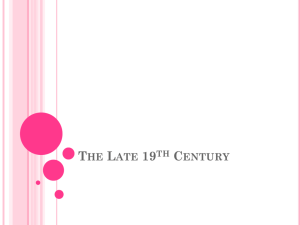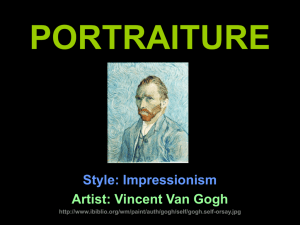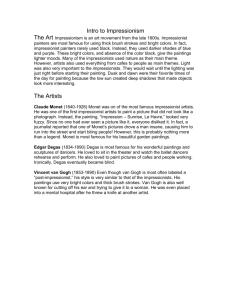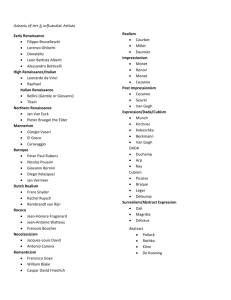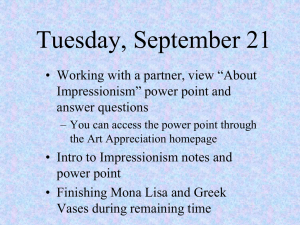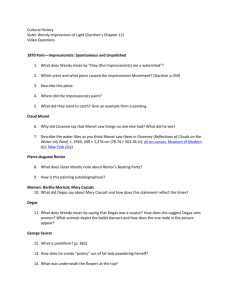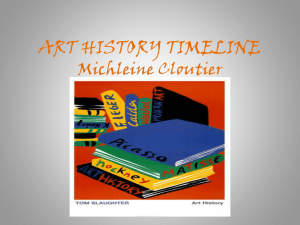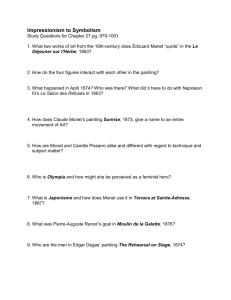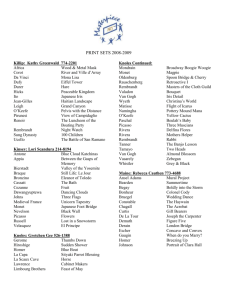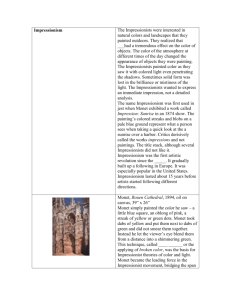Ch. 18: Toward the Modern Era
advertisement
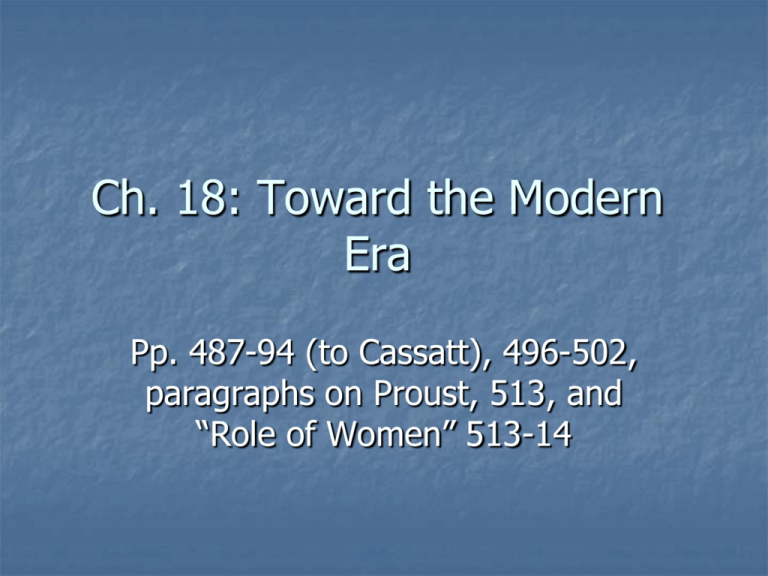
Ch. 18: Toward the Modern Era Pp. 487-94 (to Cassatt), 496-502, paragraphs on Proust, 513, and “Role of Women” 513-14 Featured Works Monet’s Red Boats at Argenteuil Degas’s The Rehearsal and The Tub Van Gogh’s Starry Night Munch’s The Scream Ibsen’s Doll House Other Important Works Renoir’s Le Moulin d la Galette Gaudi’s Casa Mila Proust’s Remembrance of Things Past Terms Ubermensch Impressionism and post-Impressionism Fauvism and Expressionism Stream of Consciousness writing Realism “removing the fourth wall”) Overview Think of this period (late 19th and very early 20th centuries—before WW I) as a period in which some striking changes are beginning to occur; the effects of the war and of the Depression will intensify some of these changes and take us into what we think of as the modern era. On the whole, you will see that the Classical interest in the human subject and the Renaissance Humanist interest in the individual— developing the individual’s talents and capabilities and exploring our “inner” selves—has led us to a greater emphasis on the individual in this period. At the same time, social forces that affect the individual are of great interest to intellectuals, and sometimes a considerable concern. Philosophy Who was Friedrich Nietzsche, and which of his books does your author discuss? How did Nietzsche break away from certain traditional cultural values in his philosophy? (Be able to explain Ubermensch.) Impressionism: Claude Monet Claude Monet, Red Boats at Argenteuil Go to the link below to learn more about Monet. Be sure to click on “Waterlilies” and expand the images of those paintings to get a good look: http://www.ibiblio.org/wm/paint/auth/monet/ Edgar Degas, The Rehearsal and The Tub. More on Degas: http://www.ibiblio.org/wm/paint/auth/degas/ Post-Impressionism Paul Cezanne, Mont Sainte-Victoire More on Cezanne: http://www.ibiblio.org/wm/paint/auth/cezanne/ Vincent van Gogh, The Starry Night More on van Gogh: http://www.ibiblio.org/wm/paint/auth/gogh/ Fauvism and Expressionism Edvard Munch, The Scream More on Munch: http://www.ibiblio.org/wm/paint/auth/munch/ Antonio Gaudi, Casa Mila If you will google “Gaudi” and click “images,” you will get a little look at the wild and wooly world of Gaudi’s architecture. From Proust’s Remembrance of Things Past, which is the first example of “stream of consciousness” writing; just read these two slides before class. The Cookie Many years had elapsed during which nothing of Combray, save what was comprised in the theatre and the drama of my going to bed there, had any existence for me, when one day in winter, on my return home, my mother, seeing that I was cold, offered me some tea, a thing I did not ordinarily take. I declined at first, and then, for no particular reason, changed my mind. She sent for one of those squat, plump little cakes called "petites madeleines," which look as though they had been moulded in the fluted valve of a scallop shell. And soon, mechanically, dispirited after a dreary day with the prospect of a depressing morrow, I raised to my lips a spoonful of the tea in which I had soaked a morsel of the cake. No sooner had the warm liquid mixed with the crumbs touched my palate than a shudder ran through me and I stopped, intent upon the extraordinary thing that was happening to me. An exquisite pleasure had invaded my senses, something isolated, detached, with no suggestion of its origin. And at once the vicissitudes of life had become indifferent to me, its disasters innocuous, its brevity illusory - this new sensation having had on me the effect which love has of filling me with a precious essence; or rather this essence was not in me it was me. I had ceased now to feel mediocre, contingent, mortal. Whence could it have come to me, this all-powerful joy? I sensed that it was connected with the taste of the tea and the cake, but that it infinitely transcended those savours, could, no, indeed, be of the same nature. Whence did it come? What did it mean? How could I seize and apprehend it? . . . [skipping several paragraphs!] And suddenly the memory revealed itself. The taste was that of the little piece of madeleine which on Sunday mornings at Combray (because on those mornings I did not go out before mass), when I went to say good morning to her in her bedroom , my aunt Léonie used to give me, dipping it first in her own cup of tea or tisane. . . . [skipping the rest of the paragraph] And as soon as I had recognized the taste of the piece of madeleine soaked in her decoction of lime-blossom which my aunt used to give me (although I did not yet know and must long postpone the discovery of why this memory made me so happy) immediately the old grey house upon the street, where her room was, rose up like a stage set to attach itself to the little pavilion opening on to the garden which had been built out behind it for my parents (the isolated segment which until that moment had been all that I could see); and with the house the town, from morning to night and in all weathers, the Square where I used to be sent before lunch, the streets along which I used to run errands, the country roads we took when it was fine. And as in the game wherein the Japanese amuse themselves by filling a porcelain bowl with water and steeping in it little pieces of paper which until then are without character or form, but, the moment they become wet, stretch and twist and take on colour and distinctive shape, become flowers or houses or people, solid and recognizable, so in that moment all the flowers in our garden and in M. Swann's park, and the water-lilies on the Vivonne and the good folk of the village and their little dwellings and the parish church and the whole of Combray and its surroundings, taking shape and solidity, sprang into being, town and gardens alike, from my cup of tea. Ibsen’s A Doll ‘s House and Realism in the Theatre In addition to the information in the textbook, use the link below for a plot summary of the play: http://plays.about.com/od/plays/a/dolls_summar y.htm
